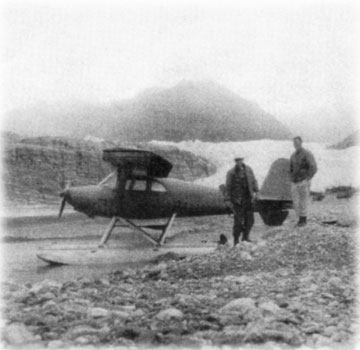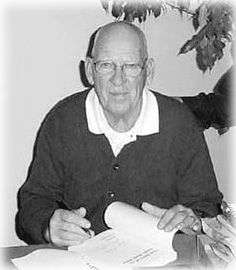 There's Giegers in them thar hills Bokan Mountain and the Alaska uranium "Boom" By Dave Kiffer July 10, 2005
The electricity for her meal was the first generated by Niagara Mohawk, America's first nuclear power plant, located in upstate New York.
Also in July of 1955, Canada announced that it would soon open its first nuclear plant and that atomic energy would meet 75 percent of country's electrical needs by 1970. American officials predicted 55 percent of the country's electricity would be nuclear generated by 1980. The Atomic Energy Commission certainly believed in the future of domestic nuclear power. In the early years after World War II, the United States imported nearly 90 percent of its uranium from Africa and Canada. So the AEC moved to spur native development of uranium for weaponry and potential electric power by spending nearly $2.5 billion to encourage production, according to historian Raye Ringoltz. "The AEC constructed roads into the backcountry, promised $10,000 bonuses for new lodes of high-grade ore, guaranteed minimum prices and paid up to $50 per ton for .3 percent ore, constructed mills, helped with haulage expenses and posted geologic data on promising areas," Ringoltz wrote in "Uranium Frenzy, Boom and Bust on the Colorado Plateau." By the mid 1950s, there were more than 800 uranium mines operating in the Colorado plateau alone. Grizzled prospectors like Charles Augustus Steen and Vernon Pick became folk heroes and instant multi-millionaires by selling their claims to larger companies. The rush to find enough uranium to meet the expected needs was officially on as prospectors combed much of the western part of the country, looking not for color in a stream, but for the clicking of a Geiger counter Oddly enough, despite its reputation as the mineral storehouse of America, federal government officials didn't expect to find much uranium in Alaska. One of the leading experts in the field, Robert Nininger of the Atomic Energy Commission wrote a book called "Minerals for Atomic Energy." In it, he said that Alaska was unlikely to have much uranium. In fact, he believed that little uranium would be found at all in the coastal mountains from the Aleutians to Mexico. In general, the AEC believed that most commercial grade uranium was located in the Rockies and parts of the Great American Basin of the Southwest. Specifically, the Four Corners area where Colorado, Utah, New Mexico and Arizona meet. But officials in Alaska felt that there was uranium in the territory. They encouraged uranium prospecting in the 1950s. A bulletin from the Territorial Department of Mining in the spring of 1955, stated that 1955 would be the year that uranium would be discovered in Alaska. The prospectors themselves needed little encouragement. In his book, "Nine Lives of an Alaskan Bush Pilot" Ketchikan's Ken Eichner talks at length about prospecting in the hills of Southern Southeast and British Columbia in the 1950s. "I was bitten by the uranium bug so this was the era when everywhere I went, I was flying with a nucliometer (a larger, more powerful version of the Geiger counter) fastened to my airplane," Eichner wrote. "That meant I was flying into every little nook and cranny that I could into. It was a funny thing . The tighter into it you got, the better the readings were. It was kind of a sucker thing for us, but we soon learned that when the mountains started to close in you, what little uranium activity there was would be concentrated so you would get a higher reading, even though there wasn't a higher content of uranium."
In his book, Eichner indicated he also thought that Southern Prince of Wales might have uranium and planned to take a look at it in 1954. "As fate would have it, one day I had a trip down to MacLean Arm (toward Cape Chacon on the southern tip of POW)," Eichner wrote. "On the way back, I decided to fly the nucliometer past Bokan Mountain, but on the way there I hit some heavy turbulence and had to turn aside." Bokan Mountain would prove to have the largest then known uranium deposit in Alaska, but its discovery would have to wait a year for the combined efforts of Ketchikan's Don Ross, Kelly Adams and Bill Easton. In April of 1956, The Alaska Sportsman - the predecessor of Alaska Magazine - published a lengthy account of the trio's efforts . Adams, a geologist, disagreed with the federal mines assessment of the uranium potential in Alaska and Ross and Easton agreed with him. They put aside $6,000 to cover their costs. It was decided that Ross - the more experienced pilot - would work full-time on the venture. Adams would be the mechanic/geologist and Easton the financial advisor and bookkeeper. In April of 1955, they formed the Uranium 55 syndicate. "Kelly Adams, pilot, geologist, aircraft mechanic and longtime prospector reasoned that Alaska lands could possess valuable deposits of uranium because they definitely had other minerals," wrote B.G. Olson in The Alaska Sportsman. "Don Ross , a successful young pilot and a close friend of Adams agreed with him. Bill Easton, another friend and successful businessman, was also interested in this new adventure.". They purchased a nucliometer and a Piper Cub J-3. In late April, Ross started flying over Prince Of Wales Island, the most likely location. On May 18, Ross was flying with his wife Jan when they got a very high reading above Bokan Mountain, a 2,500 foot peak between Moira Sound and Kendrick Bay at the south end of Prince Of Wales. Poor weather prevented them from landing at the site, but the next day Ross and Adams returned. "Suddenly the nucliometer went crazy," Olson wrote. "It flipped clear off the dial at the least sensitive settingThe prospectors then had to find some way to reach the "hot spot" without landing on the salt water and leaving their plane to the mercy of the tidesThey decided that Hessa Lake, about two miles from the outcropping, would be the best bet." Ross and his wife Jan returned the next day, landed at the lake, hiked to the outcropping and staked the site. The syndicate had only been looking for two weeks. Samples were sent out for analysis to the Atomic Energy Commission under heavy secrecy because the group didn't want any competition on the mountain. Knowing that it would take weeks to get a full report, the Uranium 55 also contacted Art Glover, the assayer-engineer in Ketchikan for the Territorial Department of Mines who examined the ore samples and then contacted Phil Holdsworth, the territorial Commissioner of Mines in Juneau. Holdsworth then flew to the mine site and took a number of samples. He met with the syndicate and then contacted the Climax Molybdenum Company in Colorado. Climax sent employees to Ketchikan in June to investigate the claim. Their tests indicated it was high grade ore, even higher than the uranium ore that was being currently mined in the Rockies. By now, it was no longer possible to keep the work a secret and banner headlines heralding the big "POW" discoveries began appearing the Ketchikan Chronicle and the Ketchikan Daily News. The syndicate sold some shares for additional operating capital and staked 14 more claims around the hotspot. Other locals rushed to the area and began prospecting the nearby mountains. "In Southeastern Alaska, especially around Ketchikan, rumors started to leak out about "the big strike on Prince Of Wales," Olson wrote in The Alaska Sportsman. "Claim jumpers turned up , caused trouble, then disappeared again. Ross had to 'ditch' other planes which tried to follow him every time he headed for the claim." Members of the syndicate went to Seattle to begin negotiations with Climax. Olson reported that Uranium 55 initially asked for $5 million for the claim. The company declined and entered into five days of negotiations. The result was that Climax gave Uranium 55 $25,000 for the right to prove up and explore the claim for one year. At the end of the year, Climax agreed to pay the syndicate an additional $55,000, plus $50,000 a year or 25 percent of the profits whichever was greater until 1960. The Kendrick Bay Mining Corporation was founded. Mining began in 1957 and continued sporadically until 1971. Initially, the company used an open-pit mine but then switched to underground mining. Approximately 90,000 tons of ore was removed from the site, according to the Alaska Department of Commerce and Economic Development. One of the challenges reported by the Commerce Department was that most of the ore was in the .1 percent range and not high enough to economically feasible except in time of great demand The biggest effort was in 1971, when 50,000 tons were mined by C&M Construction on Montana. According to the Ketchikan Daily News, a mile and half long road was built to get the ore to tidewater where it would be loaded on barges. "Forty men now live in the self-contained quarters that can hold up to 42," the Daily News reported in the summer of 1971. "They work three shifts a day, seven days a week. (Company officials) said the ore should be extracted by the middle or end of September." It was reported that most of the uranium would be sold to electric companies for nuclear power plants. But even by 1971, the "boom" was clearly off the nuclear rose. It was an example of the government giveth and the government taketh away. "Utah alone had produced approximately nine million tons of ore valued at $25 million by the end of 1962, " Ringoltz wrote. " But then the industry almost came to a standstill. The AEC, now holding ample reserves, announced an eight-year limited program, and finally completely stopped buying uranium in 1970. Private industry triggered a brief second boom when nuclear power plants came on line in the mid-70s, but foreign competition, federal regulations and nuclear fears virtually put an end to domestic uranium mining." The multi-billion dollar bankruptcy of the nuclear based Washington Public Power Supply System and the nuclear accidents at Three Mile Island and Chernobyl in the late 1970s and 1980s further turned the public against civilian use of nuclear power. In the latter part of the 20th century, many of the older nuclear plans began decommissioning while the public debate raged over how to safely dispose of the spent nuclear fuel. Although Bokan Mountain is dormant these days, there is still interest some in uranium mining., particularly in light of the country's increased reliance on foreign oil supplies, The 6,000 acre Boulder Creek property near Nome is the largest deposit found to date in Alaska and preliminary work continued on site development this spring, according to the web site for Full Metal Minerals LTD of Vancouver B.C.
Contact Dave at dave@sitnews.us Dave Kiffer ©2005
|
|||

